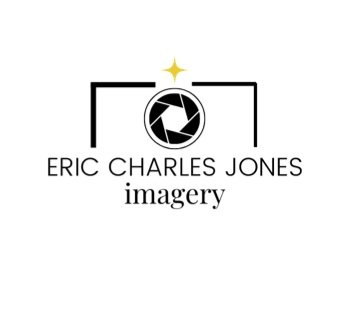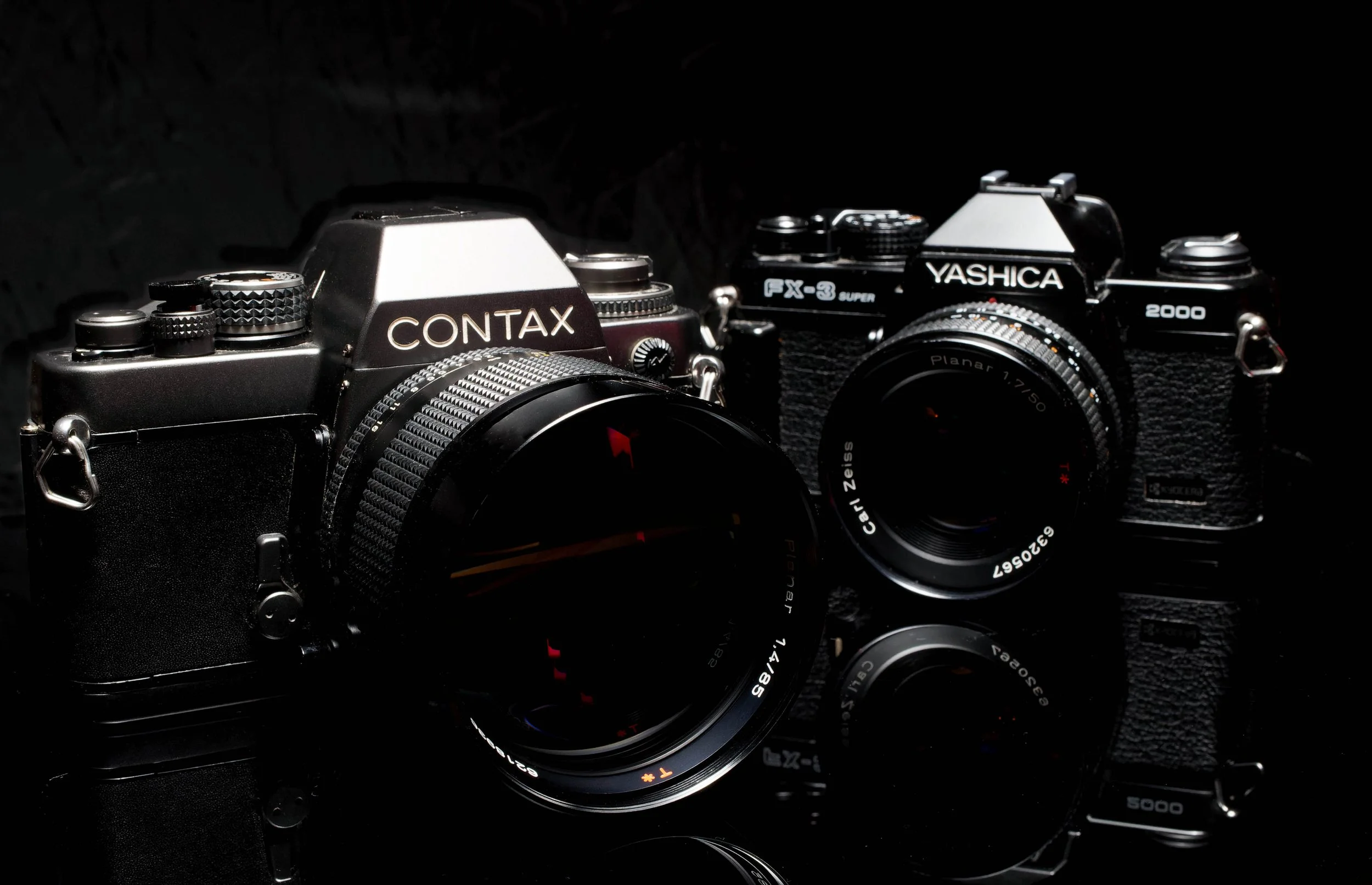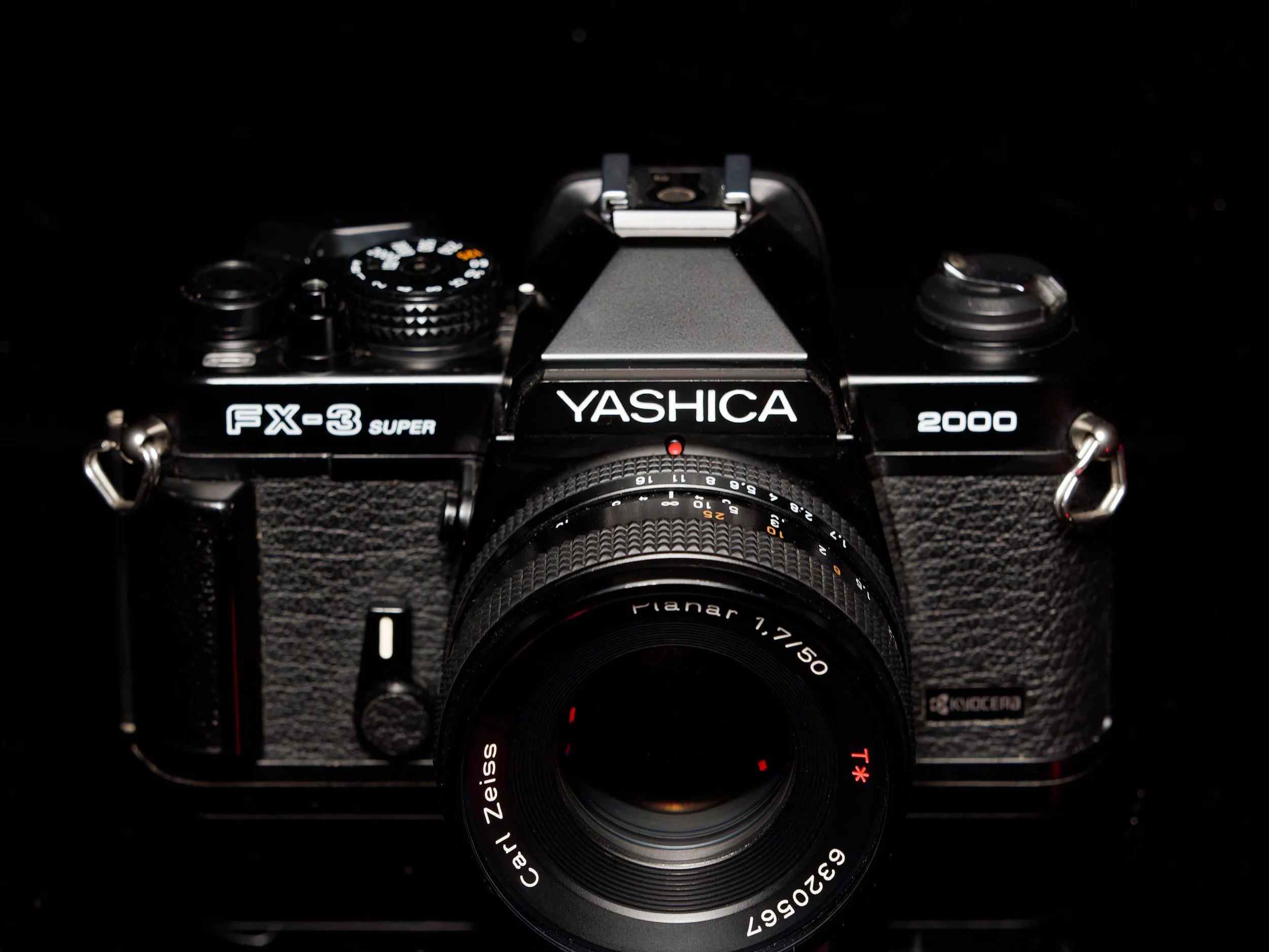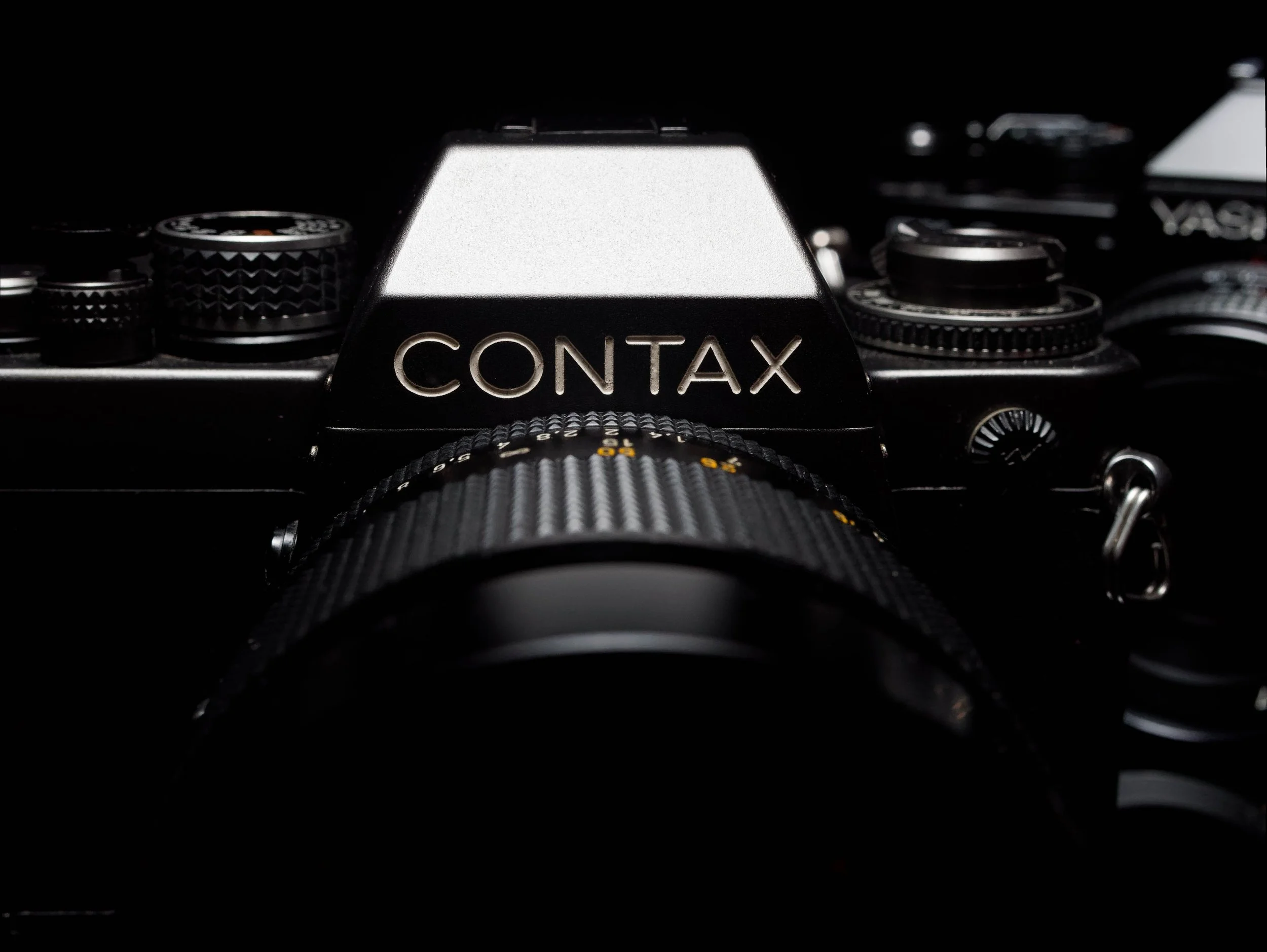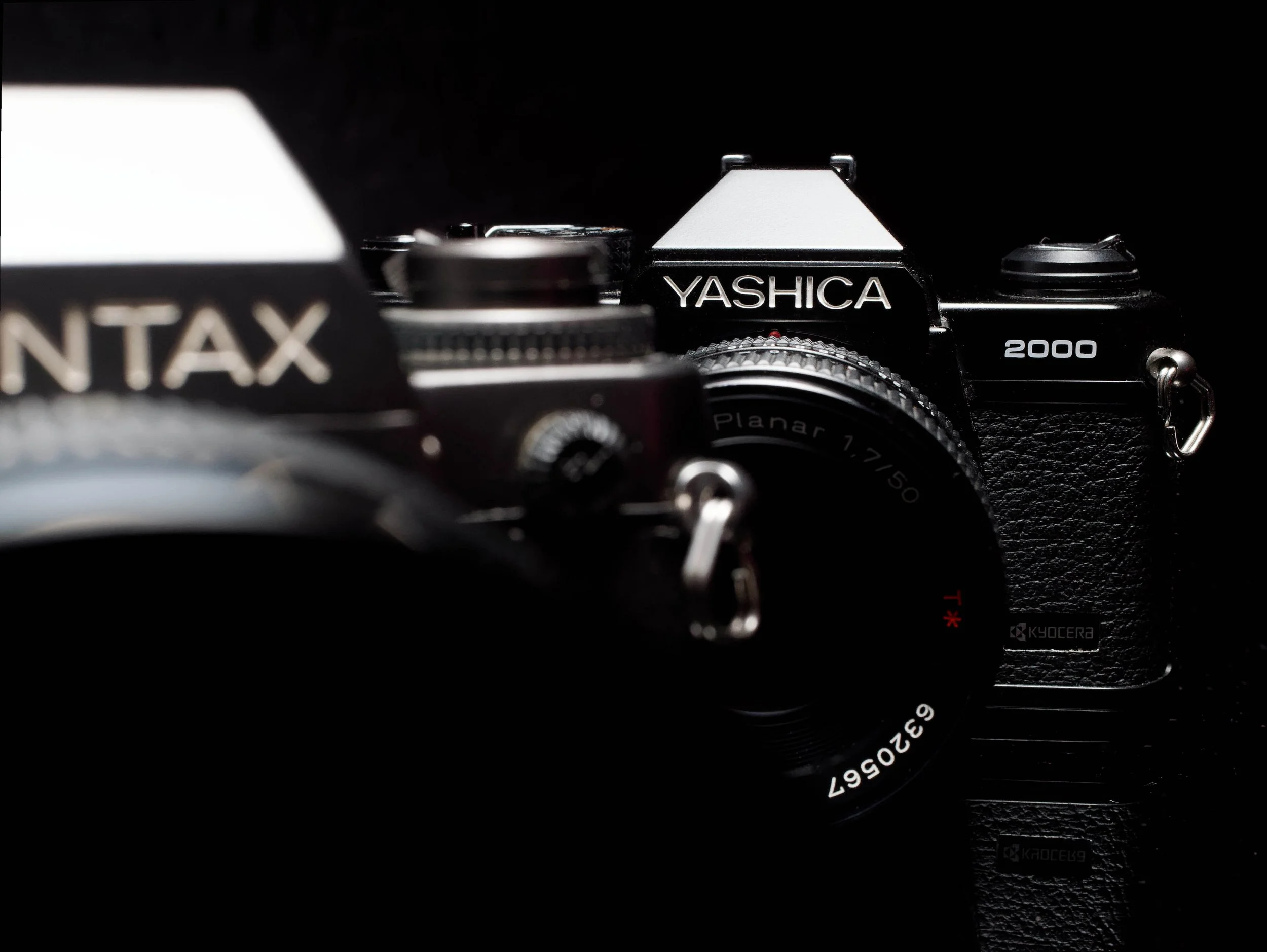Shared Simplicity: The Yashica FX-3 Super 2000 and The CONTAX S2b
“Our life is frittered away by detail. Simplify. Simplify.
- Henry David Thoreau
There are times when the only thing I want as a photographer is simplicity: film, a box for capturing light, a great lens, and a reliable light meter. The Yashica FX-3 Super 2000 introduced in 1986 and the CONTAX S2b entering the market in 1994 satisfies these photographic needs. Both are minimalist cameras with mechanical shutters and both share the Yashica/CONTAX (C/Y) lens mount.
The FX-3 Super 2000 was often promoted to the beginner photographer learning the fundamentals. Whereas, the CONTAX S2b was marketed to the experienced photographer yearning to return to their photographic roots. Both cameras follow the same philosophy of simplicity. A straightforward approach to photography.
History
Yashica was founded in Nagano, Japan in 1949. Within a few decades, the camera producer would establish itself as a major manufacturer of reliable low-cost cameras. On the other side of the globe in Germany, Carl Zeiss had built a long-established reputation and tradition for producing outstanding world-class optics dating back to its origins in 1846.
In 1973, both companies began collaborating to produce high-end amateur and professional cameras with battery-operated electronic shutters. Carl Zeiss previously produced cameras under the name Contax but the line would be rebranded as CONTAX with clean capital letters. During this re-imagining, Carl Zeiss would design and develop the prestigious camera and lens line while Yashica would be responsible for their manufacturing.
By 1983, Yashica would be acquired by the Japanese conglomerate, Kyocera. During this era, CONTAX would make some truly outstanding and innovative cameras, many of which have reached cult status with film shooters (the G-series, the T-series, the CONTAX 645). In 2005, in a corporate decision, Kyocera would completely abandon the camera market. First, retiring the CONTAX brand and allowing its rights to eventually return to Zeiss. Then, three years later, Kyocera would sell the trademark rights of Yashica Inc. to Hong Kong-based MF Jebsen Group.
Yashica FX-3 Super 2000 Specifications
Body: Plastic body w/ black or gray metal bottom and top plates
Type: 35mm focal plane shutter SLR
Lens Mount: Contax/Yashica
Shutter: Mechanical, vertical travel, metal shutter
Shutter Speed: Manual: 1 to 1/2000 sec, B, X 1/125 sec (flash sync). Self-timer: Mechanical; 10 sec delay
Shutter release: Mechanical w/cable release socket
Exposure: Manual exposure w/ metering sensor: SPD cell
Metering range: (ISO 100 f/1.4).
Yashica FX-3 Super 2000: Center-weighted average EV 2 to EV 19 (TTL)
Film speed: ISO 25 to 3200
Viewfinder: Fixed eye-level pentaprism finder w/ diopter adjustment and 8 optional diopter lenses (via CONTAX)
Focusing Screen: fixed split-image/microprism Viewfinder: 0.91x mag and 92% field of view
Viewfinder display: LEDs for flash indicator, over/under exposure warning
Film transport: manual film advance and rewind
Power: 2x 1.5V LR44 batteries with battery check
Dimensions: 135 (W) x 84.5 (H) x 50 (D) mm
Weight:445g without batteries
The Yashica FX-1 was introduced in 1975. It was the first Yashica with the C/Y (CONTAX/Yashica) mount. There were several iterations of this popular camera culminating in the final version, the Yashica FX-3 Super 2000 (1986). The camera was targeted as an entry-level basic camera.
The top and bottom plates are made of metal while the body is made of plastic. If you can get past its plastic construction, it’s a very competent and reliable camera. It has a small integrated hand grip but it could be deeper to accommodate larger hands. The controls are elemental but well-placed. On the right side of the top plate is the shutter speed knob. There is the bulb setting (B), and shutter speeds range from 1 second to 1/2000 of a second. Flash sync speed tops off at 1/125 of a second. Integrated within the same knob are your ISO settings. The ISO range is 25 to 3200.
Next to the shutter speed knob, is the shutter release button that allows for a threaded cable release. Exposure lock is achieved by pressing the shutter release button halfway. Adjacent is the film advance lever. On the left side of the top plate is the film rewind crank.
On the front of the camera, there is a 10-second self-timer.
Inside the viewfinder the LED display is simple. (+) for overexposure (-) for underexposure and ( ◯ ) for correct exposure. If a flash is attached and the unit is on and charged, a flash symbol is displayed
Yashica manufactured its line of lenses. Lenses ranged from their 'DSB' budget-friendly lenses, which have single-coated optics to the more expensive premium range of lenses 'ML' for multi-layered or 'MC' for multi-coating lenses. Although I have never used Yashica lenses, their ML and MC lenses are well-regarded. Sharing the C/Y mount with CONTAX also gives the photographer access to the highly praised line of Carl Zeiss T* lenses.
CONTAX S2b SPECIFICATIONS
Body: Dark gray titanium bottom, front, and top casing. Leather covered body
Type: 35mm focal plane shutter SLR
Lens Mount: Contax/Yashica
Shutter: Mechanical, vertical travel, metal shutter
Shutter Speed: Manual: 1 to 1/4000 sec, B, X 1/250 sec. (flash sync). Self-timer: Mechanical; 10 sec delay
Shutter release: Mechanical w/cable release socket, release lock
Exposure: Manual exposure w/ metering sensor: SPD cell
Metering range: (ISO 100 f/1.4).
S2b: Center-weighted average EV 2 to EV 20 (TTL)
Film speed: ISO 12 to 6400
Viewfinder: Fixed eye-level pentaprism finder w/ diopter adjustment and 8 optional diopter lenses
Focusing Screen: Interchangeable, Viewfinder: 0.82x mag and 95% field of view
Viewfinder display: LEDs for flash indicator, over/under exposure warning and shutter speeds
Film transport: manual film advance and rewind
Power: 2x 1.5V LR44 batteries with battery check
Dimensions: 134.5 (W) x 89(H) x 51(D) mm
Weight: 565g without batteries
The CONTAX S2b (1994) was the follow-up to the CONTAX S2 (1992). It has a more photographer-friendly center-weighted light metering system as opposed to the spot meter on the CONTAX S2. Its mechanical shutter was a deliberate departure for CONTAX. All previous CONTAX models (during the Yashica/Kyocera era) were dependent on battery-powered electronic shutters.
The S2b was marketed as an elegant, refined, minimalist but rugged take-anywhere camera. The camera for the photographic purest. It feels solid and well-engineered in your hands. It has the feel and the look of a classic old-school camera.
The bottom, top, and front plates are made of dark gray titanium. The front and rear of the body are enclosed in soft leather (many cameras are suffering from bubbling or peeling leather but replacements can be found online). As with the Yashica, the controls are Spartan. It has a slightly different layout from the Yashica. On the top right plate, the shutter speed knob has a bulb (B) mode. Shutter speeds range from 1 second to a fast 1/4000 of a second. Flash sync speed tops off at a very respectable 1/250 of a second. Next to the shutter speed dial is the shutter release button that also accepts a threaded cable release. The exposure lock is engaged by half-pressing the shutter release button. It also sports a shutter release lock. Next is the film advance lever. Under the lever, is a smaller lever that allows for multiple exposures.
On the left side of the top plate rests the ISO knob. The ISO range is 12 to 6400, and integrated within the knob is the film rewind crank.
As with the Yashica, on the front of the camera near the lens release button is a 10-second self-timer.
Inside the viewfinder are basic LED indicators. On the right side of the viewfinder, are indicators for overexposure, underexposure, shutter speeds, and flash ready. However, TTL flash synchronization functions are not available with both the Yashica FX-3 Super 2000 and CONTAX S2b.
The heart and soul of all CONTAX cameras are their lenses. CONTAX produced several legendary lenses during this period.










Conclusion
The beauty of both the Yashica and CONTAX cameras is their simplicity and the experience while shooting. These basic mechanical cameras require one to operate slower, be more deliberate, be more measured, and be engaged with one’s subject or the environment. It’s about the process.
Both cameras are uncomplicated and functional. So, there are no unnecessary dials or knobs, there is little distracting you. Both perform their stated goal, simply taking pictures. It’s reassuring knowing that batteries are not needed to operate the cameras. They are only required to power their light meters.
As of this writing, a mint copy of an FX-3 Super 2000 is averaging around $200. The rarer CONTAX S2b will put you back over $1000 for an exceptional sample. The S2b is an improvement over the Yashica in terms of shutter speed, ISO film range, flash synchronization, build quality, etc. but are these improvements worth 5 times the price? Will a titanium camera body give you a better shooting experience or make you a better photographer? No. If you want access to some of the truly exceptional Zeiss glass then the Yashica is excellent value. If you want the full CONTAX experience with a manual shutter then the S2b is the pricier option (The CONTAX S2 is cheaper but uses the less forgiving spot meter). If your goal is simplicity and you have an affinity for Zeiss glass then you can’t go wrong with either The CONTAX S2b or The Yashica FX-3 Super 2000.
